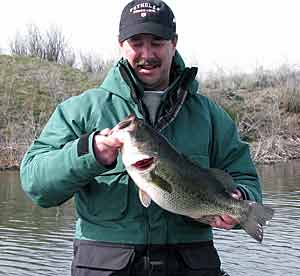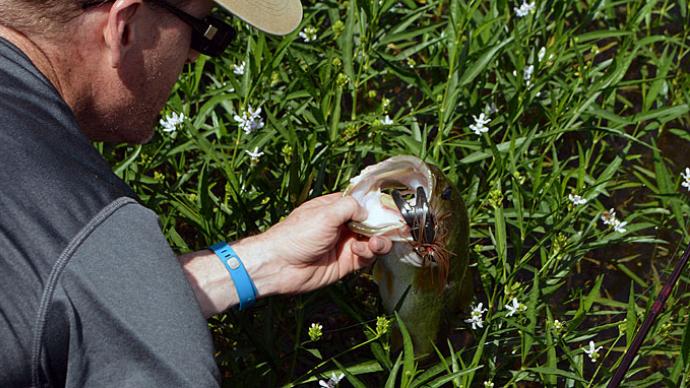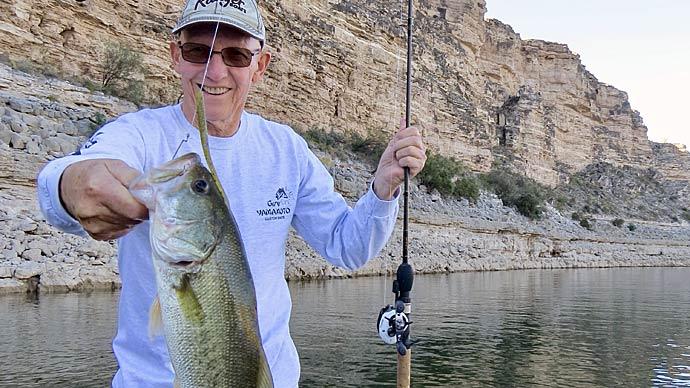
As the saying goes, “The knot in your line is the weakest link between you and your bass.” Losing a bass that makes a mighty leap and throws your hook can be frustrating, but having one break off your knot is infuriating. Considering the importance of choosing and correctly tying the right fishing knot, it is surprising how little information is devoted to the topic in bass fishing articles and television fishing shows. Even the various books l have read about bass fishing cover only the basics about fishing knots and knot tying, with no significant depth on the topic. This article is intended to remedy the situation.
Line Matters
A fishing knot can never be any better than the line used to tie it. So before getting into the specifics about knots, consider the following general precautions to take about the line itself.
First, use only premium fishing line brands to ensure your line is high in quality and correctly labeled for essential characteristics like pound-test ratings and line diameter.
Second, store spare spools of line in a sealed, dry container and place it in a dark, cool place to avoid deterioration.
Third, continually inspect the line on your reels and replace it when it shows any signs of wear, damage, or abrasion.
Finally, cut leaders made of nylon line (typically called monofilament) that have been in the water for any significant length of time, and switch reels or reel spools when longer sections of monofilament line are involved. Unlike fluorocarbon or braided lines, monofilament lines will weaken due to water absorption. After only one hour in the water, its average loss in strength is fifteen percent and could be as high as twenty percent. So, a knot with ninety percent of line strength tied with ten-pound test line that starts with about nine pounds of strength when dry could end up with only about seven pounds of strength after an hour’s fishing. And since monofilament is typically used with top-water presentations, an added benefit is that new line has greater buoyancy than when water logged.
Knot Rules
There are two causes of knot failure: Slippage and breakage. Slippage can occur for two reasons: Tying the wrong fishing knot for the type of line used, or improperly tying the right knot. Breakage also can occur for two reasons: Strain on the knot exceeds knot strength, or improperly tying the knot causes it to break under strain that does not exceed potential knot strength.
Bass anglers can go a long way towards preventing knot slippage and breakage by adhering to the following rules.
- Select a knot that will not slip with the chosen line. Some knots that work well with monofilament and fluorocarbon line will slip with braided line. Some fishing line manufacturers recommend knots; check out their websites.
- Select a strong knot for the purpose you have in mind (line to lure, line to line, etc.) Do not settle for a knot because it is simply familiar or popular. Instead, focus on knots that rate at least ninety percent of line strength. Google “fishing knots” and review various knots to check out their strength ratings.
- Select a knot that you can repeatedly tie correctly on the water. Some knots, while very strong, are too complex. You would have a difficult time tying them correctly under field conditions such as wind, rain, cold, and low light or when pressured by circumstances to tie speedily.
- Select a versatile knot. For example, the Uni knot is a multipurpose knot that can be used for attaching the line to a hook, lure, or swivel (passing the line twice through the eye of the hook is the improved Uni knot or Fishin’ Fool knot.) The Uni is also suitable for attaching line to line of similar diameter, attaching the line to a reel spool, and even snelling a hook. With a versatile knot, you do not have to remember and become skilled at tying a different knot for every purpose. However versatile the knot, you still may need to learn other knots for other purposes. For example, to tie directly to certain lures instead of using a split ring or snap (see below), you will need to learn a loop knot. To connect lines of very dissimilar diameters, you may need to use an Albright knot or an Improved Blood knot. And if you fly-fish, you may need to tie a nail knot to connect your fly line to your leader.
- Before attempting to tie your chosen knot on the water, practice tying it at home with the same line used when fishing. You will develop techniques enabling you to tie it quickly and accurately. Continue practicing until you can tie the knot without thinking about your actions. Line used this way is a worthwhile investment in preventing knot slippage and breakage.
- Lubricate knots before tightening to reduce friction. Friction creates heat that weakens monofilament and fluorocarbon lines, causing knot breakage. Many anglers use saliva or water as their lubricant. For an exceptionally smooth snug-down, moisten the line and wrap it with a tiny dab of liquid floating gel used on dry flies by fly fishermen.
- After a knot is tightened, pull the main line, gradually putting some pressure on it to ensure it is tied correctly. If it is not, it is far better that it slips apart or breaks in your hands instead of when your trophy bass is at the end of the line.
- When cutting off tag ends, be careful not to nick knots by trimming too close. Also, use a line cutter or scissors made for the type of line being used to avoid putting an undue strain upon the knot. Such tools are available from several tackle manufacturers. Finally, never use your teeth to cut the line because doing so causes excessive dental wear and could result in chipped teeth.
- If you use your teeth as a ”third hand” when tying a knot, to avoid damaging the line or knot, do not bite down on the main line or any portion of the line that will go into the knot. The only part of the line you should bite down on is the tag end that will be trimmed off. Also, if you tug on the line held in your teeth, be very careful about putting too much pressure on your teeth to avoid damaging them.
- Do a visual inspection of each knot to be sure all the wraps are correctly laid out next to one another. Overlapping wraps can put undue pressure on an underlying wrap causing a knot to break under strain far short of its pound test rating. If a knot looks odd, it was likely not appropriately tied. Cut it off and retie.
- When using monofilament and fluorocarbon lines with a strength rating lower than ten-pound test, take more care when tying, lubricating, tightening, and inspecting your knots. Due to the inherently lower strength of light line and the fact that knots have even less strength than the line’s test strength, to begin with, it is essential not to risk any avoidable weakness. Also, be aware that braided line below twenty-pound test (typically, the equivalent monofilament diameter being six-pound test) is so thin that knots tied with it require more care to inspect adequately compared to thicker lines of thirty to sixty-five-pound test.
- Whenever possible, pre-tie knots before going on location to avoid tying subject to the difficulties of field conditions. For example, if you are drop-shotting, split-shotting, or Caroling rigging, you can pre-tie leaders from the swivel down with any needed hooks, sinkers, and trailing line. Then you can store your pre-tied leaders in the compartments of a leader wallet or the bags of a small worm binder. Shimano, Plano, and Daiwa manufacture different styles and sizes of leader storage systems. Then, when you need to replace a leader, you can cut it off on the main line side of the swivel and quickly tie your main line to the swivel of the pre-tied leader, eliminating the need to tie any other knots on location.
- Rig your terminal tackle using as few knots as combinations of lines and different fishing techniques require. Despite your precautions, every knot between your reel and your bass is a potential point of failure.
- If your rod tip guide has a ridge of metal like hard chromium, replace it with a guide that has an insert of material such as chromium oxide, Alconite, or Zirconia. This will protect line-to-line knots using monofilament or fluorocarbon line by reducing both friction and impact damage that occurs every time the knot is dragged over the plain metal rim while under the pressure of fighting a fish.
- When attaching the line to a split ring, be sure the knot is not tightened in the ring’s split but instead on the opposite side of the split. Otherwise, the sharp edges of the ring where it opens up may weaken the knot by nicking or cutting into it. Since fighting or playing a bass may shift the position of a knot to the opening in the split ring, it is necessary to inspect a knot’s location on the split ring regularly. Alternatively, there are two ways you can avoid the hazard of the split in the ring altogether and still retain the lure’s ability to move side to side upon retrieval. Either remove the split ring and tie the line directly to the lure using a loop knot or tie the line to a snap, which facilitates quick lure changes.
- Protect knots from weakening due to strain and abrasion. Once a bass is removed from the water, the buoyant force of the water no longer counteracts the bass’s weight. So lift fish from the water with a net instead of hoisting them with your line to avoid placing unnecessary strain on your knots. Also, keep bullet weights from bumping into your knots by separating them from the weights using a glass bead with smoothed edges around the center hole to prevent abrasion. As an added precaution, such a bead can be held next to a knot with a bobber stopper anytime the knot is dragged over the structure or pulled through cover that might damage it.
- When using a trailing line, as in drop-shotting, attach the weight to the end of the line using a weaker knot than the knot tied to the hook. If you must break off because the weight gets hung up in rocks or wood, you can save your hook and lure while not placing excessive strain on the hook knot. In addition, depending on your chosen knot, you may be able to weaken the trailer knot simply by using far fewer wraps, say one or two wraps instead of six or seven with a Uni knot, thereby avoiding the need to learn a different knot for this purpose.
- After each catch, visually inspect your knots. If a knot shifted on the eye of the hook or tie point of a lure during the fight with the fish, readjust it. Also, retie if a knot looks odd since the position of knot wraps can alter under the strain of the twists and turns placed on a knot when fighting a fish.
- Retie knots periodically, even if they look fine, because they may be weakened by the strains placed on them in the ordinary course of fishing. Retie after landing a giant bass, catching a series of moderate-sized bass, or even after pulling a smaller bass through thick weeds. The lower the pound test of the line, the more critical it is to retie in such situations. For example, a knot of ninety percent line test strength tied with eight-pound test line has only about seven pounds of strength, to begin with. Diminish that with the weakening due to strain, and the remaining knot strength may be inadequate for your next catch.
- Do not put more strain on the knot than it can handle based on its strength. For example, if you are using twenty-pound test line and tie on a knot with ninety percent of line test strength, do not exceed eighteen pounds of strain. Check the reel manufacturer’s guidebook on how to set the drag, and always set the drag to account for the strength of your weakest knot instead of the strength of the line.
Following these rules, I have failed only one knot in the past two years. But, unfortunately, in my haste to retie and cast to some actively feeding bass, I violated rule seven, resulting in knot slippage. So I am confident that bass anglers tying fishing knots according to the precepts listed above will experience fewer if any, knot failures.
|
Image

About the Author Vince LaZara is a retired college professor who regularly angles avidly for largemouth bass in various southeastern Arizona lakes.
|




